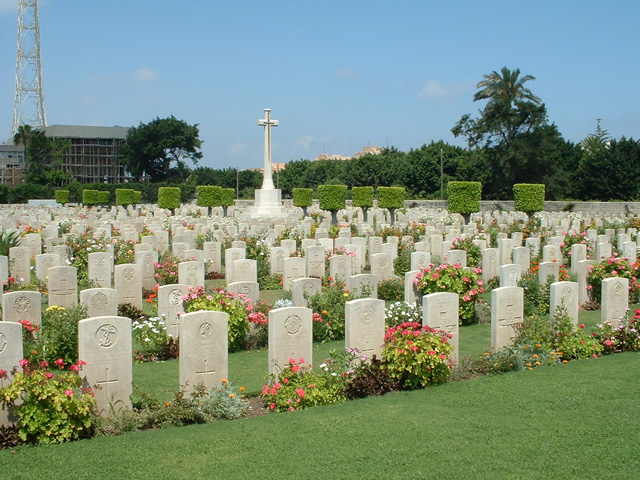Alexandria (Hadra) War Memorial Cemetery
- Country Egypt
- Total identified casualties 2954 Find these casualties
- Identified casualties from First & Second World War
- GPS Coordinates Latitude: 31.20378, Longitude: 29.92303
Cemetery Spotlight: Alexandria (Hadra) War Memorial Cemetery

Hadra War Cemetery is a significant Commonwealth War Graves Commission site, commemorating soldiers who died during World War I and World War II. Established as a burial ground for those who perished in Alexandria’s hospitals, it contains over 1,700 WWI and 1,300 WWII graves.

The cemetery reflects Alexandria’s role as a key medical and logistical base during both wars and honors soldiers from various nationalities, including British, Australian, Indian, and South African and other forces. Featuring a Cross of Sacrifice, it serves as a place of remembrance for those who fought in the North African and Middle Eastern campaigns.
The cemetery holds many lesser known yet fascinating stories that highlight the human side of war. It reflects Alexandria’s crucial role as a wartime medical hub, where soldiers from different backgrounds fought, suffered, and were cared for before being laid to rest.
Some graves belong to servicemen who survived battles only to succumb to illness or injuries in the city's hospitals, while others mark the resting places of engineers, medics, and support personnel who played vital but often overlooked roles.

The day-to-day maintenance of Hadra War Cemetery involves care to uphold the highest standards. Our dedicated gardeners work with great commitment to ensure the site remains a place of dignity and remembrance. Their routine tasks include maintaining the grave rows, mowing the lawns, and caring for the flowers, trees, and plants. They also ensure that the memorials and headstones are kept clean throughout the year, preserving the site's beauty and honoring those who rest here.
In addition to regular maintenance and tasks, the team focuses on technical tasks related to irrigation systems and its spare parts, optimizing water usage. They also carry out turf improvement works, including scarification and aeration in spring or fall to enhance grass health. Other specialized technical works are implemented to maintain the overall quality and sustainability of the site.

To achieve this balance, we implement several best practices, such as adjusting irrigation schedules to minimise water loss due to evaporation, typically watering in the early morning or late evening to ensure that the sensors are working properly and automatically.
Additionally, we conduct regular inspections to detect and repair any leaks in the irrigation system or pipes, preventing unnecessary water waste. In certain areas, such as hedges and trees, we replaced the sprinklers with drip irrigation, ensuring more efficient water use while keeping them well-maintained.

Our team is committed to sustainability policies to preserve our sites in Alexandria.
We carefully manage pruning waste by recycling plants to reduce resource consumption. Grass cuttings and other green waste is turned into natural compost that improves the soil and supports plant health. Additionally, we handle non-green waste responsibly, following environmental regulations to minimise our ecological impact.
To reduce water consumption, we implement smart irrigation strategies that prevent overwatering while ensuring healthy plant growth. Along with maintenance, we recognise that cemeteries are also valuable green spaces that support biodiversity. Through these and other efforts, we remain committed to long-term environmental sustainability.
Location information
Hadra is a district on the eastern side of Alexandria and is south of the main carriageway to Aboukir, known as Al Horaya, near the University of Alexandria.
The Cemetery is on the road Sharia Manara. The junction of this road and Al Horaya is diagonally opposite the University of Alexandria.
Visiting information
Opening times:
Saturday to Thursday: 7.00am to 14.30pm.
Friday: closed
The cemetery is kept locked outside of these hours.
For further information and enquiries please contact enquiries@cwgc.org
History information
In March 1915, the base of the Mediterranean Expeditionary Force was transferred to Alexandria from Mudros and the city became a camp and hospital centre for Commonwealth and French troops. Among the medical units established there were the 17th, 19th, 21st, 78th and 87th General Hospitals and No 5 Indian Hospital. After the Gallipoli campaign of 1915, Alexandria remained an important hospital centre during later operations in Egypt and Palestine and the port was much used by hospital ships and troop transports bringing reinforcements and carrying the sick and wounded out of the theatres of war.
This cemetery was begun in April 1916 when it was realised that the cemetery at Chatby would not be large enough. Most of the burials were made from the Alexandria hospitals, but a number of graves of December 1917 were due to the loss of the troop transports "Aragon" and "Osmanieh" which were sunk by torpedo and mine as they entered the port. The cemetery continued in use until December 1919 but later, some graves were brought in from small burial grounds in the western desert, Maadia and Rosetta.
During the Second World War, Alexandria was again an important hospital centre, taking casualties from campaigns in the Western Desert, Greece, Crete, the Aegean Islands and the Mediterranean. Rest camps and hostels were also established there together with a powerful anti-aircraft base. Alexandria was also the communications centre for the middle and near east and became the headquarters of the Military Police. The cemetery at Hadra was extended for Second World War burials and was used from 1941.
There are now 1,700 First World War burials in the cemetery and 1,305 from the Second World War. The cemetery also contains war graves of other nationalities and some non war burials.



